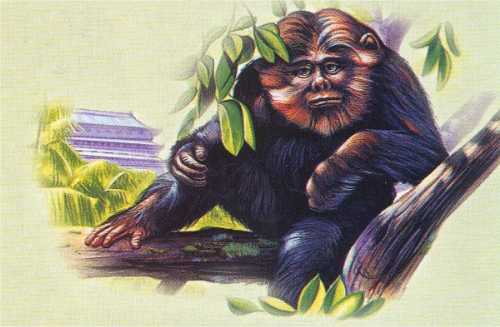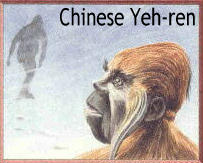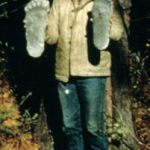The Yeren (Chinese: 野人; literally “wild-man”), also known as the Yiren, Yeh Ren, Chinese Wildman, or Man-Monkey is an alleged hominid residing in the mountainous forested regions of China’s remote Hubei province.
Description
Biologist Wang Tselin who claimed to have examined a specimen describes him as follows:

“The creature stands fully erect like a human an are about 6 feet tall. The legs are of human proportions relative to their stature with elongated arms. The level of the chin is above that of the shoulder, a very human trait but there is little projection of the nose. Interestingly, the sloping forehead rise up above the eyes like in humans rather than back like in the gorilla.
It has deep-set eyes, protruding lips, horse-like front teeth and bulbous nose with slightly upturned nostrils. He has sunken cheeks, ears like a man’s but bigger, and round eyes also bigger than a man’s. His eyes are black and he is covered in long, dark brown.
His whole face, except for the nose and ears, is covered with short hairs. His arms hang down to below his knees. He has big hands about half a foot long and with thumbs only slightly separated from the fingers. He walks upright with his legs apart. His feet are about a foot long.”
Size :Its height varies from 6 to 9 ft tall. A smaller version that is only 3 ft tall has also been sighted. hairy all over. It had thick lips and big teeth, like a horse’s. and its arms were very long and its feet were huge.
Color :Reddish or brownish (sometimes greyish) hair covers his body
Folkore
The Wildman has been a part of the folklore of southern and central China for centuries. Apparently ancient Chinese literary works and folk legends include references to big hairy manlike creatures which live in the vast forests of the Quinling-Bashan-Shennongjia, a mountain region of central China (northwest Hubei province).
It seems that even Shennong, god-king of fable and father of husbandry and farming, was deterred by their altitude and had to build a scaffolding when he came here to collect medicinal herbs. The area even got its name from Shennong and the Chinese word jia meaning ‘scaffold’.

Two thousand years ago, during the Warring States period, Qu Yuan (340-278 B C), the statesman-poet of the State of Chu, referred in his verse to ‘mountain ogres’. His home was, significantly, just south of Shennongjia, in what is today the Zigui county of Hubei province.
In Tang dynasty times (A D 6I8-907) the historian Li Yanshou in his Southern Historydescribes a band of ‘hairy men’ in the region of modern Jiangling county, also in Hubei.
Later still, the Ch’ing dynasty poet, Yuan Mei (1716-98), in his book New Rhythms tells of the existence of a creature described as `monkey-like, yet not a monkey’ in south-western Shaanxi province, Xianning county.
The first Chinese emperor, Hwang-Ti, builder of the Great Wall, may have had an unwitting hand in Yeti-making. According to an ancient legend, some people tried to avoid compulsory labour on the wall by taking to the forests and hiding there where, even after many generations, their descendants became wild, large and hairy but retained the power of speech. They emerged periodically from the forest and enquired, ‘Has the wall been finished yet?’. But, although the answer was ‘Yes’, they didn’t believe it and returned to the forest where, alas, reality is about to catch up with them.
Sightings
The first scientific observation of a Chinese Yeti was made in I940 by Wang Zelin, a biologist graduated from the Faculty of Biology at Chicago.
“Around September or October, we were travelling from Baoji to Tianshui via Jiangluo City; our car was between Jiangluo City and Niangniang Plain when we suddenly heard gunshots ahead of us. When the car reached the crowd that surrounded the gunman, all of us got down to satisfy our curiosity. We could see that the ‘wildman’ was already shot dead and laid on the roadside. The body was still supple and the stature very tall, approximately 2 metres. The whole body was covered with a coat of thick greyish-red hair which was very dense and approximately onecunlong. Since it was lying face-down, the more inquisitive of the passengers turned the body over to have a better look. It turned out to be a mother with a large pair of breasts, the nipples being very red as if it had recently given birth. The hair on the face was shorter. The face was narrow with deep-set eyes, while the cheek bones and lips jutted out. The scalp hair was roughly one chi long and untidy. The appearance was very similar to the plaster model of a female Peking Man [the Chinese Homo erectus]. However, its hair seemed to be longer and thicker than that of the ape-man model. It was ugly because of the protruding lips. According to the locals, there were two of them, probably one male and the other female. They had been in that area for over a month. The ‘wildmen’ had great strength, frequently stood erect and were very tall. They were brisk in walking and could move as rapidly uphill as on the plain. As such, ordinary folks could not catch up with them. They did not have a language and could only howl.”
Although widely considered a superstitious myth in contemporary Chinese society, the Yeren boasts a history of sightings by scientists and dignitaries, rather than just common folk. In 1940, biologist Wang Tselin claimed to examine the corpse of a Wildman that had been killed in the Gansu region. He said it was a female specimen over six feet tall, with striking features that appeared to be a cross between ape and human. Geologist Fan Jingquan in 1950 reported seeing Wildmen live and in the flesh, a pair that he construed as mother and son, in the forests of the Shanxi province.
In 1961, a team of road builders allegedly killed a female Yeren in the forests of Xishuang Banna. By the time officials from the Chinese Academy of Sciences investigate, the body had disappeared. The scientists’ investigation concluded that the creature, which was described as only four feet tall, had been an ordinary gibbon. But twenty years later, a journalist who had been involved in the investigation came forward to claim that the creature killed was no gibbon, but an “unknown animal of human shape.”

On 14 May 1976 Six cadres from the Shennongiia forestry region were driving along the highway near Chunshuy, a village between Fangxian county and Shennongjia, when they came across a strange tailless creature covered in reddish fur, illuminated in the headlamps of the car. This initiated a great degree of public interest, people writing in to report other sightings and groups of scientists and the army mounting expeditions into the forest. A massive expedition of more than 100 members including scientists, photographers and special infiltration teams of soldiers with rifles, tranquillizer dart guns, tape recorders and hunting dogs, worked in the area during 1976 and 1977, interviewing hundreds of people. Together with army scouts and commune members, the team organized several large searches, but (as is usual with such expeditions) they found nothing definite. At one point the expedition search party moved near to one of the creatures; unfortunately ‘before the beast could be captured an anxious soldier accidentally shot himself in the leg. The shot brought expedition members scurrying in from all directions and presumably frightened the creature away.
The closest thing to concrete proof of the Yeren’s existence surfaced in 1980 in the form of the preserved hands and feet of an unknown hominid creature. Supposedly, villagers had killed a Wildman in the Zhejiang province in 1957, and a biology teacher had removed and preserved all four of its extremities. Upon examining the hands and feet, researcher Zhou Guoxing at first announced that they belonged to an unknown species of monkey, but later decided they had come from a large macaque monkey.
Another large scale expedition. operated between 1980 and 1985 near Songbai in Shennongjia forest. More than two hundred footprints were collected on Mount Quiangdao at 2,400 m. The footprints discovered on the first occasion were 48 cm in length, with an average stride of 2.5 m. Many eyewitness accounts have also been recorded but again no “wild man” was captured or photographed.
Kidnapping
A curious incident was reported in the Daily Telegraph for 2 December 1980 under the sensational title, ‘Chinese Child Fathered by Apeman’. The Telegraph’s special correspondent in Peking had read in the official daily paper (Guangming) an account of a woman who had disappeared for twenty-seven days in 1939 in ‘a forest area frequented by the “wild men of Hupen [Hubei]” province’. The mountainous area referred to is clearly Shennongjia, and the human interest of the story stems from the fact that the woman claimed she was captured by ‘wildmen’ and later gave birth to a ‘monkey child’. The offspring of this dubious union, the so-called ‘monkey child’ of the headline, died in 1960 aged twenty-one, but its bones, according to the Guangming daily, have recently been dug up, and examination showed that ‘the child’s skeleton had the characteristics of an ape and a man’.
Theories
The Chinese incline towards the view that their creature is related to Gigantopithecus, a giant extinct primate believed to have lived in China three hundred thousand years ago.
A monkey species that has also been suggested as a candidate for Wildman sightings is the rare and endangered golden monkey (pic above), whose unusual appearance could seem like a man-monster to some observers.








